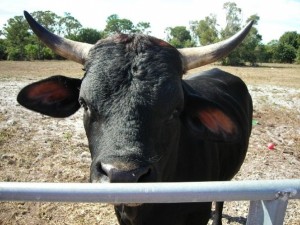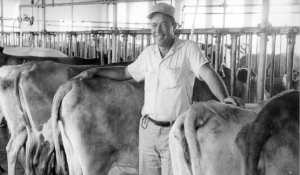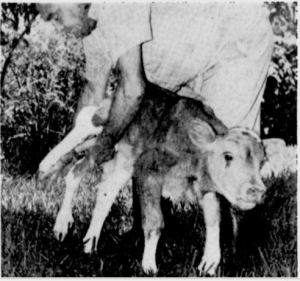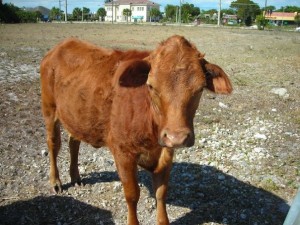I guess there has to be a last of everything, and in Boynton’s proud dairy history, these are indeed the last. The last cows of Boynton are in their 12 acre pasture, tucked between a gas station, a development and Knuth Road. You may have driven past them on Boynton Beach Boulevard. I often
take kids there to feed the cows carrots, so they can see what a real cow looks like. One evening we were lucky enough to meet Mrs. Winchester, who came by to check on them. There was a nostalgic gaze on her face as she told me of the days when thousands of cows grazed across Boynton’s prairies. She laughed as she told me her first name – Elsie! A perfect name for a dairyman’s wife.
These last cows hold the secret of all those that came before them. Boynton’s flat drained sandy and muck soils were ideal for cattle grazing, and in the 1920s,  the Model Land Company encouraged people to enter the dairying business.  The first large scale dairy had some very lucky cows, who enjoyed an ocean view. In 1920, Ward Miller decided that the lands that today make up Briny Breezes would make a fine dairy. Being near the ocean, diseases brought by ticks would be less of a problem. In 1923, he built the Shore Acres Dairy, along with owning the Miller-Jordan Dairy on Federal Highway, while W.S. Shepard had the Royal Palm Dairy.
Another large dairy in the early days of Boynton dairying was Bertana Farms, owned by A.E Parker and located on the Dixie Highway. He was also part owner of the Alfar Creamery in West Palm Beach, and a former city manager of West Palm Beach; much of the milk from Boynton was processed through the Alfar Creamery. Harry Benson and E.L. Winchester also had their dairys on the eastern side of Boynton.
As land along the ocean and the Dixie highway became more valuable, dairies began to pop up along the Military Trail, Lawrence Road and what would eventually become Congress Avenue (Congress was not put through Boynton until 1965). One of earliest and most famous dairy families of Boynton were the Weavers. Their dairy was located along the Military Trail, where the Cypress Creek Golf Club is today. M.A. Weaver served as mayor of Boynton for many years, and their house still stands in Lake Boynton Estates. His sons had land north and south of Boynton Beach Boulevard on Military Trail, all of which was eventually sold for developments and shopping. Stanley Weaver was also very much involved in Boynton, serving as mayor in the 1950s and serving longer than anyone else ever has on the Lake Worth Drainage District Board. The Boynton Canal is now named in his honor.
Many other families also entered the dairy business. The Melear family, from Alabama, had many dairies in Palm Beach County. In a June 25, 1955 article from the Palm Beach Post Historical Archives, the eight brothers and one sister had over 2,200 head of cattle and 2,800 acres of land. All of the Melear siblings settled in Palm Beach County, except one who stayed on in Hawaii after World War I. Carlton Melear had his place at Hypoluxo Road and Congress Avenue. At the time it was built, there was no Congress Avenue, so when the road was put through in 1965, two cattle paths were built under
the road so the cows could get to the milking barn on the west side of Congress without disturbing traffic (see earlier post on my memory of the cows on Congress here). That property today is The Meadows development, including the Meadows Square Plaza, where the Melears’s house once stood. Tyler Melear had his dairy on Lawrence Road north of what today is Gateway, C.B. Melear was on Old Boynton, Bill Melear and Charlie Melear were on Boynton West Road (today’s Boynton Beach Boulevard) and operated the Learwood dairy, and Lester Melear was on Lantana Road west of the Turnpike. A sister was even in the business. Nonnie Melear White and her husband Louis White were also on Boynton West road. The Melears milk was distributed through the McArthur, Alfar and Boutwell Dairies.
The 1945 Florida Census for Boynton Beach listed several people with the profession of “dairyman” – C.F. Knuth and his son Orville and his Few Acres Dairy at Lawrence and Old Boynton, A.E. Allen at the Eldorado Dairy, the Winchesters (who also raised pineapple), the Williamson and Goodman Dairy, the Goodwin Dairy, Harry Benson’s Gulf Stream Dairy, Albert Teele, who ran a “milk counter” in the Northwood neighborhood of West Palm Beach, B.L. Tuck on Lawrence Road, and Herbert Keatts and Grover Bell, who had their dairies on the Military Trail.
Walter Goolsby and his son Theodore ran Goolsby and Son Dairy along the Boynton Canal and Lawrence Road. They had 20 acres on the west side of Lawrence (where the Artesa development is today) and a hundred acres on the east side of Lawrence, which actually was originally platted in 1927 as the “West Boynton” subdivision. They bought both pieces of land at tax sales. They were featured in
the Palm Beach Post in 1960 when a five-legged calf was born at the dairy. The Goolsby children sold the West Boynton subdivision portion in 1977, and the developer simply took the original 1927 plat and sold lots. These are the avenues today called Aladdin, Barkis, Coelebs, Dorit and Edgar.
As time went by, the land was becoming more valuable and the profit margin in the dairy business was razor thin. The inflation pressures and oil crisis of the early 1970s were the last blows to both the Weaver dairy in Boynton and the Melear dairy on Congress. Both were closed by 1973. Many of the cow herds were moved to the Okeechobee area to larger operations. Some cows remained across from the Boynton Beach Mall until about 2005, when the land was sold for the Boynton Commons shopping center.
So few today are even aware that Boynton Beach played such a large role in dairy production in South Florida. I miss seeing the cows across from the Boynton Mall; it somehow allowed me to believe that I
still lived “in the country.” I know that very soon the last ones will too be gone, bringing a whimpering end to almost 100 years of dairying history in Boynton. Take a ride out and visit them while they are still there.
This story was researched through the Palm Beach Post Historic Archives, the 1945 Florida Census, Â and a history written by B.W. White, courtesy of the Boynton Beach City Library and Janet DeVries, archivist.
Â








My comment is this , I do miss the country view of seeing cows, when my husband and our 3 daughters moved down from Ohio, in the year 1988, my husband worked for Morrisons’s Cafeteria in the Boynton Beach Mall. We loved coming over where we lived in Lake Worth to see the cows and visit him at work.
[WORDPRESS HASHCASH] The poster sent us ‘0 which is not a hashcash value.
I’m relatively new to Palm Beach County…moved here in the late ’90s, but am at least proud to remember visiting the Boynton Beach Mall when there were still cows across Congress. Loved to read about this 🙂
[WORDPRESS HASHCASH] The poster sent us ‘0 which is not a hashcash value.
It’s seems to be happening all over Florida – the cows are disappearing . I was looking to see if my grandfather was associated with any of the dairies in 1931 – since my mother was born on a dairy in Boynton in that year. His name was Joseph Carl Register.
Thank you for sharing this story. We moved here in 1977and I am one who loves the good old days and I love reading about the history of Palm Beach County.